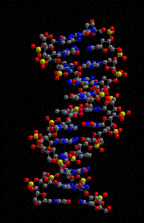DNA /Nucleic Acids
Nucleic Acids contain __________ and ___________ as their examples. DNA is responsible for the code of every ______________ in an organisms body. The monomers of DNA are called _______________. Each of these ________________ contains a sugar, one of 5 different bases and a phosphate.
This is an example of a simple nucleotide.
|
|
|
|
| | | ||
| P |
There are 2 types of sugars : ___________________ and __________________.
There are 5 types of bases: DNA contains : Adenine, Guanine, Cytosine, and Thymine. while RNA contains: Adenine, Guanine, Cytosine, and Uracil.
Draw the 4 different types of nucleotides for DNA in the space below: Use D for the sugar and the underlined letters for the bases. The P is the same in all nucleotides.
|
|
|
|
|
|
|
|
The nucleotides can only combine in the following order: A - T and C - G. The bases never touch the P.
Let us produce a DNA molecule using the following sequence
of DNA bases:
|
|
|
|
|
|
|
|
|
|
|
|
|
|
|
|
|
|
|
|
|
|
This DNA will twist several times forming the unique
cork screw shape called the __________________.

RNA is a bit different in structure, since it has the base Uracil replacing Thymine. The sugar is different since Ribose replaces the Deoxyribose in the nucleotide. Most of RNA has a linear structure and not that of a ladder. RNA's functions vary from taking the code for a protein to the ribosome(m-RNA) to bringing in the correct amino acids to produce the protein (t-RNA).
DNA Replication: This is the process by which DNA produces an exact copy of itself. There are 4 basic steps to this procedure.
1. DNA unwinds. 2. The double helix will unzip. 3. The complementary bases will be added to each side of the old molecule. and 4. the DNA's will rewind or twist.
Each of the 2 DNA molecules will contain 1/2 new material and 1/2 of the original molecule.
